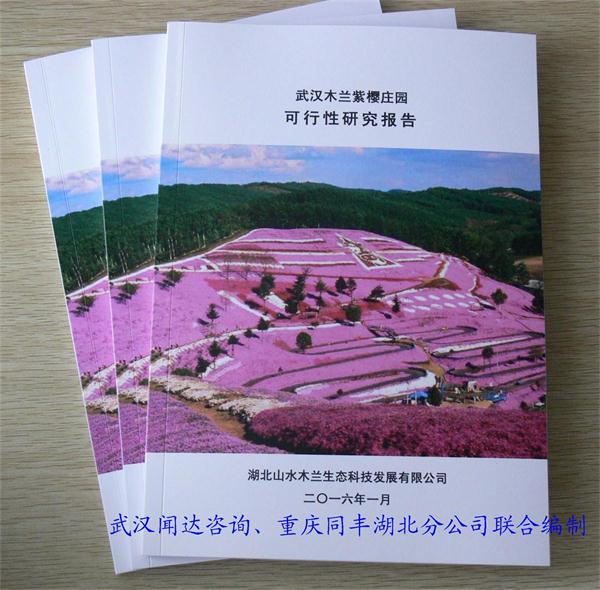
天门年产20万吨肥料添加剂加工项目可行性研究报告是由专业的可行性报告编写公司--湖北闻达独家最新编制的报告,集合湖北一流的专家团队,按时保质完成编写任务,远低于同行编写价格的同时,也保证了所编报告一次性通过的质量,上千企业合作经验,值得您的信赖!报告相关内容:【报告价格】面议【交付方式】特快专递+电子邮件据更新等服务。天门年产20万吨肥料添加剂加工项目可行性研究报告编写目录第一章总论1.1项目概述1.1.1项目名称1.1.2项目建设单位及简介1.1.3项目法人代表及介绍1.1.4项目简介1.2项目编制依据与原则1.2.1项目编制依据1.2.2项目编制原则1.3项目建设内容及规模1.3.1项目建设内容1.3.2项目建设规模1.4项目设备选择及工艺流程1.4.1项目设备种类、数量1.4.2项目工艺流程1.4.3项目技术方案1.5项目投资估算与资金筹措1.5.1项目投资估算1.5.2资金筹措1.6项目建设进度1.7财务分析1.7.1项目财务分析1.7.2项目经济技术指标1.8项目结论及建议1.8.1项目结论1.8.2项目建议第二章背景和必要性分析2.1项目提出的背景2.1.1国家或行业发展规...

仙桃年处理50万吨原矿选矿项目可行性研究报告由集合湖北一流专家团队的湖北闻达独家编写完成,此仙桃可行性报告远低于同行编写价格的同时,保证了一次性就通过的编写质量,深得业主的赞赏,上千企业合作经验,值得您的来电咨询!报告相关内容:【报告名称】仙桃年处理50万吨原矿选矿项目可行性研究报告【报告价格】面议【编制机构】湖北闻达伟业咨询有限公司【表现形式】文字分析、数据比较、统计图表【订购电话】027-85600618(万经理)【交付方式】特快专递+电子邮件【售后服务】一年目录范围之内,免费提供内容补充,数据更新等服务。仙桃年处理50万吨原矿选矿项目可行性研究报告第一章总论1.1项目概述1.1.1项目名称1.1.2项目建设单位及简介1.1.3项目法人代表及介绍1.1.4项目简介1.2项目编制依据与原则1.2.1项目编制依据1.2.2项目编制原则1.3项目建设内容及规模1.3.1项目建设内容1.3.2项目建设规模1.4项目设备选择及工艺流程1.4.1项目设备种类、数量1.4.2项目工艺流程1.4.3项目技术方案1.5项目投资估算与资金筹措1.5.1项目投资估算1.5.2资金筹措1.6项目建设进度1...

潜江年产280吨复合天然抗氧化剂项目可行性研究报告是由专业的可行性报告编写公司--湖北闻达独家最新编制的报告,集合湖北一流的专家团队,按时保质完成编写任务,远低于同行编写价格的同时,也保证了所编报告一次性通过的质量,上千企业合作经验,值得您的信赖! 报告相关内容:【报告名称】潜江年产280吨复合天然抗氧化剂项目可行性研究报告 【报告价格】面议【编制机构】湖北闻达伟业咨询有限公司【表现形式】文字分析、数据比较、统计图表【订购电话】027-85600618(万经理)【交付方式】特快专递+电子邮件【售后服务】一年目录范围之内,免费提供内容补充,数据更新等服务。 潜江年产280吨复合天然抗氧化剂项目可行性研究报告 第一章 总论1.1. 项目名称和承办单位1.1.1 项目名称1.1.2 项目承办单位与法人代表1.1.3 项目建设地点1.1.4 可行性研究报告编制人1.2 研究工作内容1.2.1 研究工作的依据1.2.2 研究工作范围1.3 研究工作概况1.4 推荐方案与研究结论1.4.1 产品市场预测1.4.2 产品销售方向和方式1.4.3 生产规模与产品方案1.4.4 生产方法1.4.5 企业...

恩施水库旅游发展可行性研究报告是由专业的可行性报告编写公司--湖北闻达独家最新编制的报告,集合湖北一流的专家团队,按时保质完成编写任务,远低于同行编写价格的同时,也保证了所编报告一次性通过的质量,上千企业合作经验,值得您的信赖!据更新等服务。恩施水库旅游发展可行性研究报告1 研究总论 10-171.1 研究背景 10-121.1.1 旅游产业发展的现实地位 101.1.2 生态文明建设的战略任务 10-111.1.3 休闲度假旅游的新型业态 111.1.4 休闲农业盛行的发展模式 11-121.2 项目的必要性 12-141.2.1 建设两型社会的不二选择 12-131.2.2 保护生态环境的迫切要求 131.2.3 实现产业转型的当务之急 131.2.4 统筹城乡建设的有效途径 13-141.3 可行性研究依据 14-171.3.1 法律法规及政策 14-151.3.2 行业标准 151.3.3 其它资料依据 15-172 基本情况介绍 17-202.1 自然条件 17-182.1.1 地理位置 172.1.2 地形地貌 172.1.3 气象气候 172.1.4 河流水文 17-18...

湖北棚户区改造项目安置区建设可行性研究报告是湖北闻达最新编制完成的可行性报告,集合了湖北超强的专家团队,高效率保证了该报告在业主规定时间内完成。远远低于同行的编制价格,一次性就通过的编写质量,深得业主赞扬。上千企业成功合作经验,值得您的来电咨询!报告相关内容:【报告名称】湖北棚户区改造项目安置区建设可行性研究报告【报告价格】面议【编制机构】湖北闻达伟业咨询有限公司【表现形式】文字分析、数据比较、统计图表【订购电话】027-85600618(万经理)【交付方式】特快专递+电子邮件【售后服务】一年目录范围之内,免费提供内容补充,数据更新等服务。湖北棚户区改造项目安置区建设可行性研究报告编写目录第一章 总论1.1项目名称及承建、承办单位1.2编制程序、依据、范围及内容1.3项目概况1.4结论与建议第二章 项目建设背景及必要性2.1承办单位概况2.2项目建设背景2.3项目建设的必要性第三章 市场分析及需求预测3.1项目市场分析3.2项目市场优势分析3.3项目产品目标市场第四章 项目场址及建设条件4.1项目选址4.2项目建设条件第五章 项目建设规模及内容5.1功能定位5.2建设内容及规模第六章 ...

咸宁古城客栈投资建设项目可行性研究报告由湖北闻达最新独家编写完成,集合湖北最顶级的专家团队,保证了该报告在规定时间内编写完成,并保证一次性就通过的质量,上千企业成功合作经验,值得您的来电咨询!报告相关内容:【报告名称】咸宁古城客栈投资建设项目可行性研究报告【报告价格】面议【编制机构】湖北闻达伟业咨询有限公司【表现形式】文字分析、数据比较、统计图表【订购电话】027-85600618(万经理)【交付方式】特快专递+电子邮件【售后服务】一年目录范围之内,免费提供内容补充,数据更新等服务。咸宁古城客栈投资建设项目可行性研究报告编写目录第一章 总论1.1 项目概况1.1.1 项目名称1.1.2 项目总投资1.1.3 项目经营性质1.1.4 项目地址1.1.5 建设规模1.1.6 建设内容1.1.7 经营内容1.1.8 接待游客住宿量1.1.9 劳动定员1.1.10 项目建设进度1.1.11 主要技术经济指标1.2 编制依据和原则1.2.1 编制依据1.2.2 编制原则1.2.3 研究范围第二章 项目背景及必要性2.1 项目背景2.2 项目建设必要性2.2.1 古城是历史文化名城2.2.2 古城...

黄冈生态农业旅游观光园建设项目可行性研究报告是由专业的可行性报告编写公司--湖北闻达独家最新编制的报告,集合湖北一流的专家团队,按时保质完成编写任务,远低于同行编写价格的同时,也保证了所编报告一次性通过的质量,上千企业合作经验,值得您的信赖!报告相关内容:【报告价格】面议【交付方式】特快专递+电子邮件据更新等服务。黄冈生态农业旅游观光园建设项目可行性研究报告编写目录第一章 总论1.1 项目概况1.2 编制依据和原则1.3 承担可行性报告研究工作的单位1.4 研究范围第二章 项目背景及必要性2.1 项目背景2.2项目建设的必要性2.2.1 符合国家产业政策2.2.2 是实现繁昌经济社会可持续发展的需要。2.2.3 是增强繁昌县生态环境发展的需要2.2.4 是围绕旅游经济,优化农业结构的需要2.2.5 是发展地方旅游经济消费市场的需要2.2.6 是繁昌县旅游内容中文化含量的补充。2.2.7 是企业生存和发展的需要第三章 市场分析3.1生态农业观光园概况3.2生态农业园市场前景分析第四章 项目选择与建设条件4.1 项目选址4.2 建设条件第五章 建设规模与建设内容5.1 指导思想与基本原则5...

鄂州船舶生产线建设项目可行性研究报告就找鄂州编写可研报告超好评的公司--湖北闻达,一流的专家团队,保证所编报告不通过不收费,上千成功合作案例,值得您免费查阅咨询!报告相关内容:【报告名称】鄂州船舶生产线建设项目可行性研究报告【报告价格】面议【编制机构】湖北闻达伟业咨询有限公司【表现形式】文字分析、数据比较、统计图表【订购电话】027-85600618(万经理)【交付方式】特快专递+电子邮件【售后服务】一年目录范围之内,免费提供内容补充,数据更新等服务。鄂州船舶生产线建设项目可行性研究报告编写目录第一章 项目总论1.1 项目概况1.2 编制依据1.3 项目建设必要性1.4 投资估算第二章 投资环境分析2.1 自然环境分析2.2 宏观环境分析第三章 市场分析3.1 造船行业分析3.1.1 全球造船市场3.1.2 中国造船市场3.1.3 造船行业的趋势分析3.1.4 细分市场3.2 台州造船市场第四章 产品方案4.1 产品建设方案4.2 工艺流程4.3 主要工程内容4.3.1 设计原则4.3.2 平面布置4.3.3 土建工程4.3.4 大门及道路系统4.3.5 绿化设计4.3.6 用水与用电...

荆州涂装流水线设备生产建设项目可行性研究报告是由专业的湖北闻达独家编写完成的最新可研报告,集合湖北超一流的专家团队,保证了所编项目一次性就通过,远低于同行的价格,深得所合作过的业主的赞赏,上千合作案例,值得您的来电咨询!报告相关内容:【报告名称】荆州涂装流水线设备生产建设项目可行性研究报告【报告价格】面议【编制机构】湖北闻达伟业咨询有限公司【表现形式】文字分析、数据比较、统计图表【订购电话】027-85600618(万经理)【交付方式】特快专递+电子邮件【售后服务】一年目录范围之内,免费提供内容补充,数据更新等服务。荆州涂装流水线设备生产建设项目可行性研究报告编写目录第一章 总论1.1 项目概况1.2 编制依据1.3 编制原则1.4 承担可行性报告研究工作的单位1.5 研究范围第二章 项目背景及建设必要性2.1 项目背景2.2 项目建设的必要性第三章 市场分析第四章 厂址选择与建设条件4.1 项目选址4.2 建设条件第五章 建设规模及内容5.1 建设规模5.2 建设内容第六章 项目产品与生产工艺流程6.1 项目产品6.2 生产工艺流程6.3 设备选型第七章 建筑工程7.1 土建工程方案...

襄阳学校建设项目可行性研究报告由专业的湖北闻达独家编制完成,集合湖北一流的专家团队,保证了所编襄阳可行性报告如期在业主规定时间内完成,一次性就通过的编写质量,加上远远低于同行的价格,深得业主的赞同!上千企业成功合作经验,值得您的来电咨询!报告相关内容:【报告名称】襄阳学校建设项目可行性研究报告【报告价格】面议【编制机构】湖北闻达伟业咨询有限公司【表现形式】文字分析、数据比较、统计图表【订购电话】027-85600618(万经理)【交付方式】特快专递+电子邮件【售后服务】一年目录范围之内,免费提供内容补充,数据更新等服务。襄阳学校建设项目可行性研究报告编写目录第一章 总论1.1项目概况1.2编制依据和原则1.2.3承担可行性报告研究工作的单位1.2.4 研究的范围第二章 项目背景及必要性2.1 项目背景2.2 项目建设必要性第三章 市场分析3.1市场现状及需求3.2市场预测第四章 项目选址及建设条件4.1 建设场地选址4.2 建设条件第五章 建设方案与规模5.1 办学思想5.2 发展思路5.3 培养方向和目标5.4 技校发展规划与专业设置5.5 学校建设规模第六章 建筑工程规划6.1 总...
湖北十堰汽车装配厂可行性研究报告交给最专业的武汉闻达伟业咨询有限公司即可,100%保证通过,让您项目顺利起航!!!
报告编制范围:
本报告是在广泛收集巴西汽车装配产业发展的相关最新资料,进一步深入分析巴西城市总体发展规划及汽车装配产业政策;结合拟建项目对当地社会经济发展、汽车装配产业发展的重要性进行探讨;对项目建设背景、必要性、市场情况进行阐述;对建设规模、技术方案、工程方案进行研究;对本项目土地利用情况、总平面布置、节能减排、环境保护、劳动安全、卫生消防、组织机构等相关内容进行研究分析;运用投资项目分项详细法对项目建设投资进行综合分析研究;对本项目社会效益、社会稳定风险进行分析与评估;进而为本项目建设的决策提供可靠的依据。

湖北十堰汽车装配厂可行性研究报告编写目录
第一章 总 论
Chapter 1 General
1.1项目名称、承办单位及编制单位
1.1 Project name, organizer and enterprise
1.2 项目单位概况
1.2 Overview of the enterprise
1.3报告编制依据、原则及范围
1.3 Basis of the report compilation, principle and scope
1.4项目概况
1.4 Project overview
1.5结论、问题与建议
1.5 Conclusion, problem and suggestion
第二章 项目背景、意义及必要性
2.1 项目背景
2.1 Project background
2.2 项目建设意义
2.2 Significance of the project construction
2.3 项目建设必要性
2.3 The necessity of project construction
2.4 项目建设有利条件
2.4 The advantage of project construction
2.5 评价
2.5 Evaluation
第三章 市场分析及预测
Chapter 3 Market analysis and forecast
3.1 市场分析
3.1 Market analysis
3.2 汽车产业的发展规划
3.2 Plan for the development of the auto industry
3.3 巴西消费者的车型需求
3.3 Brazilian customers’ demand on automobile style
3.4 中国车企巴西建厂计划
3.4 Plan for China car enterprise constructs plant in Brazil
3.5 产品价格及销售收入预测
3.5 Product prices and sales benefits forecast
3.6 竞争力分析
3.6 Competitiveness analysis
3.7 市场风险分析
3.7 Analysis of market risks
3.8 市场评价
3.8 Market assessment
第四章 建设规模及产品方案
Chapter 4 The construction scale and production plan
4.1建设规模
4.1 Construction scale
4.2 建设内容
4.2 Construction content
4.3 产品方案
4.3 Product program
4.4 质量管理
4.4 Quality management
第五章 技术方案
Chapter 5 Technology solution
5.1 设计原则及目标
5.1 Design principles and objectives
5.2 工艺技术方案
5.2 Technology solutions
5.3 设备方案
5.3 Equipment program
第六章 原辅料及燃料动力消耗
Chapter 6 Raw and auxiliary material & energy consumption
6.1 主要原、辅材料消耗
6.1 The main raw and auxiliary material
6.2 主要燃料动力消耗
6.2 The main fuel energy consumption
第七章 厂址选择及建设条件
Chapter 7 Site Section And Construction Condition
7.1 建设条件
7.1 Construction Condition
7.2 基础设施条件
7.2 Infrastructure Conditions
7.3 地址选择
7.3 Site Selection
第八章 总图运输方案
Chapter 8 Assemble Drawing Of The Transportation Plan
8.1厂区概述
8.1 Overview of the plant area
8.2总图布置
8.2 General layout
8.3全场运输
8.3 Transportation
第九章 工程方案
Chapter9 Engineering proposals
9.1 设计依据
9.1 Design Basis
9.2设计原则
9.2 Design Principles
9.3建筑设计方案
9.3 Architectural Design Scheme
第十章 公用工程及其他辅助设施
Chapter 10 Public works and other ancillary facilities
10.1 给排水工程
10.1 Water Supply & Drainage Works
10.2 电力工程
10.2 Power Engineering
10.3 通风系统
10.3 Ventilation system
10.4 燃气工程
10.4 Gas Engineering
10.5 自动控制
10.5 Automatic Control
10.6 辅助生产设施
10.6 Auxiliary production facilities
10.7 防雷接地系统
10.7 Lightning Protection And Grounding Systems
第十一章 节能分析
Chapter 11 Analysis of Energy Conservation
11.1 节能依据、原则
11.1 Basis and Principles of energy conservation
11.2 能源消耗情况
11.2 Energy Consumption
11.3 节能措施
11.3 Energy-saving methods
11.4 节能效果评价
11.4 Evaluation on the energy-saving effects.
第十二章 环境影响评价
Chapter 12 Environmental Impact Assessment
12.1 编制依据、保护方针及环境现状
12.1 Basis of Compilation,Protection Policy And Environmental Status
12.2 主要污染物及影响分析
12.2 Major pollutants and impact analysis
12.3 环境保护与治理措施
12.3 Conservation and Management Measures
12.4 环境保护机构
12.4 Environmental Protection Agency
12.5 特殊环境影响分析
12.5 Analysis of the Impacts on Special Environment
12.6 水土保持措施
12.6 Soil and Water Conservation Measures
12.7 环境影响评价
12.7 Environmental Impact Assessment
第十三章 劳动安全、消防卫生
Chapter 13 Labor Safety,Fire Control and Sanitary
13.1 劳动安全
13.1 Labor Safety
13.2 卫生防护
13.2 Health Protection
13.3 消防工程
13.3 Fire Engineering
13.4 评价
13.4 Evaluation
第十四章 组织管理及人力资源配置
Section 14 Organizational management and human resources allocation
14.1管理机构组织方案和体系图
14.1 Management organization plan and system diagram
14.2 项目管理
14.2 project management
14.3人力资源配置
14.3 Human resource allocation
14.4 职工来源及人员培训
14.4 The source of the worker and staff training
第十五章 项目实施进度
Section 15 The project schedule
15.1 项目起止年限
15.1 the project year from beginning to the end
15.2 项目实施阶段
15.2 project implementation phase
15.3 项目实施进度安排
15.3 The project schedule
第十六章 工程招投标管理
Section 16 The project bidding management
16.1 招投标依据
16.1Bidding according to
16.2 招标工作原则
16.2 The bidding work principle
16.3 招标方式及组织形式
16.3Tender method and organizational form
第十七章 投资估算与资金筹措
Section 17 Investment estimation and financing collect
17.1投资估算
17.1investment estimation
17.2估算依据
17.2 Estimates based on
17.3估算说明
17.3 Estimate introduction
17.4建设投资
17.4 Construction investment
17.5项目总投资
17.5 The project total investment
17.6资金筹措
17.6 Fund raising
第十八章 财务分析及评价
Charpter 18 Financial Analysis and Evaluation
18.1 财务分析
18.1 Financial analysis
18.2 总成本费用估算
18.2 The total cost estimation
18.3 营业收入及损益计算
18.3 Revenue , profit and loss calculation
18.4 财务盈利能力分析
18.4 Financial profitability analysis
18.5 偿债能力分析
18.5 Solvency analysis
18.6 财务生存能力分析
18.6 Financial viability analysis
18.7 不确定性分析
18.7 Uncertainty analysis
18.8 财务评价结论
18.8 Financial evaluation conclusion
第十九章 社会效益分析
Charpter 19 social benefit analysis
19.1 社会效益
19.1 Social benefit
19.2 社会的影响分析
19.2 The society impact analysis
19.3 社会评价结论
19.3 Social evaluation conclusion
第二十章 社会稳定风险分析与评估
Charpter 20 Social stability risk analysis and evaluation
20.1 风险因素识别与分析
20.1 Risk Factors Identification and Analysis
20.2 社会风险分析
20.2 Social risk analysis
20.3 风险因素评估
20.3 Risk factors assessment
第二十一章 研究结论与建议
Charpter 21 Research conclusion and suggestion
21.1 研究结论
21.1 Research conclusions
21.2 问题及建议
21.2 Problems and suggestions
附图
附表